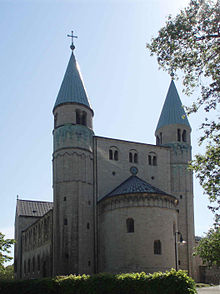Saint Cyriacus, Gernrode
| St. Cyriakus | |
|---|---|
| Stiftskirche St. Cyriakus | |

St. Cyriakus
|
|
| 51°43′28″N 11°08′10″E / 51.72437°N 11.13608°ECoordinates: 51°43′28″N 11°08′10″E / 51.72437°N 11.13608°E | |
| Denomination | Protestant |
| Website | Official website |
| Architecture | |
| Style |
Ottonian/ Romanesque |
| Groundbreaking | c. 959/60 |
| Completed | 1014 |
| Administration | |
| Province | Evangelical Church in Central Germany |
St. Cyriakus (German: Stiftskirche St. Cyriakus) is a medieval church in Gernrode, Saxony-Anhalt, Germany. It is one of the few surviving examples of Ottonian architecture, built in 959/960-965 by Margrave Gero, although it was restored in the 19th century. It is now used by the Protestant community of Gernrode.
The church is part of the tourist route Romanesque Road, as it is an important example of an Ottonian church which inspired later, fully Romanesque, churches and cathedrals.
Gero (d. 965) was a follower of Otto I from one of the most powerful families of eastern Saxony. In 937, Otto made Gero Margrave of the Eastern March. Gero, who owned a castle at Gernrode, decided to found a collegiate church and female (lay) convent (Stift) here, in cooperation with his son Siegfried. Construction on the crypt, the eastern apse and the convent started in 959. In 961, the foundation was awarded royal protection and in 963 the pope issued a privilege, which removed the convent from the influence of the Bishop of Halberstadt. Siegfried had died heirless in 959. After Siegfried's death, his widow Hathui had become abbess of the convent. Gero returned from a trip to Rome with a valuable relic of Saint Cyriacus and the church was dedicated to this saint in 963. In 965, Gero died and was buried in front of the already finished eastern choir. A hiatus in construction followed Gero's death and is seen as the likely source of the shift in the church's axis - see map. Hathui ruled the convent for 55 years until her death in 1014.
In 999, Emperor Otto III granted the convent Imperial status and in 1004, Empress Kunigunde, wife of Emperor Heinrich II visited the convent. The first stage of construction ended in 1014. That same year, on Hathui's death, Adelheid, daughter of Emperor Otto II succeeded her as abbess. Adelheid held that position until 1044.
...
Wikipedia

